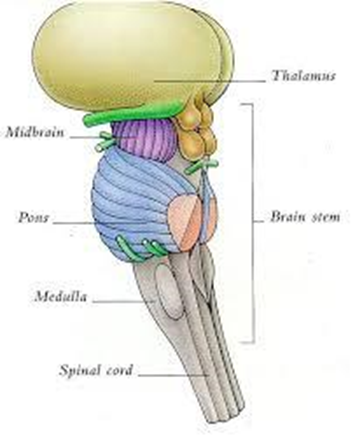Which of the following structures contains the vocal cords?
Trachea
Pharynx
Larynx
Epiglottis
The Correct Answer is C
a. Trachea: The trachea is the windpipe, a tube that carries air from the larynx to the bronchi in the lungs. It does not contain vocal cords.
b. Pharynx: The pharynx is a muscular passageway at the back of the throat that connects the nasal cavity, oral cavity, and larynx. It does not contain vocal cords.
c. Larynx: The larynx, also known as the voice box, is located in the throat and contains the vocal cords. These are two folds of muscle that vibrate when air passes over them, producing sound for speech.
d. Epiglottis: The epiglottis is a small flap of cartilage that covers the opening of the larynx during swallowing. It does not contain vocal cords.
Nursing Test Bank
Naxlex Comprehensive Predictor Exams
Related Questions
Correct Answer is B
Explanation
a: Cerebellum - The cerebellum is responsible for coordination and balance but is not where the medulla, pons, and midbrain are located.
b. Brainstem-The brainstem is composed of the medulla oblongata, pons, and midbrain. It regulates many basic physiological functions such as heart rate, breathing, and sleep.

c: Ventricles - The ventricles are fluid-filled cavities within the brain, not regions containing the medulla, pons, and midbrain.
d: Choroid plexus - The choroid plexus produces cerebrospinal fluid (CSF) within the ventricles of the brain, but it is not where the medulla, pons, and midbrain are located.
Correct Answer is D
Explanation
a. Carrying oxygenated blood from the heart to the peripheral tissue: This describes the function of systemic arteries, not the pulmonary artery.
b. Carrying deoxygenated blood from the lungs to the heart: This describes the pulmonary veins, not the pulmonary artery.
c. Carrying oxygenated blood from the lungs to the left side of the heart: This describes the function of the pulmonary veins, not the pulmonary artery.
d. Carrying deoxygenated blood from the right side of the heart to the lungs: Correct. The pulmonary artery carries deoxygenated blood from the right ventricle of the heart to the lungs for oxygenation.
Whether you are a student looking to ace your exams or a practicing nurse seeking to enhance your expertise , our nursing education contents will empower you with the confidence and competence to make a difference in the lives of patients and become a respected leader in the healthcare field.
Visit Naxlex, invest in your future and unlock endless possibilities with our unparalleled nursing education contents today
Report Wrong Answer on the Current Question
Do you disagree with the answer? If yes, what is your expected answer? Explain.
Kindly be descriptive with the issue you are facing.
